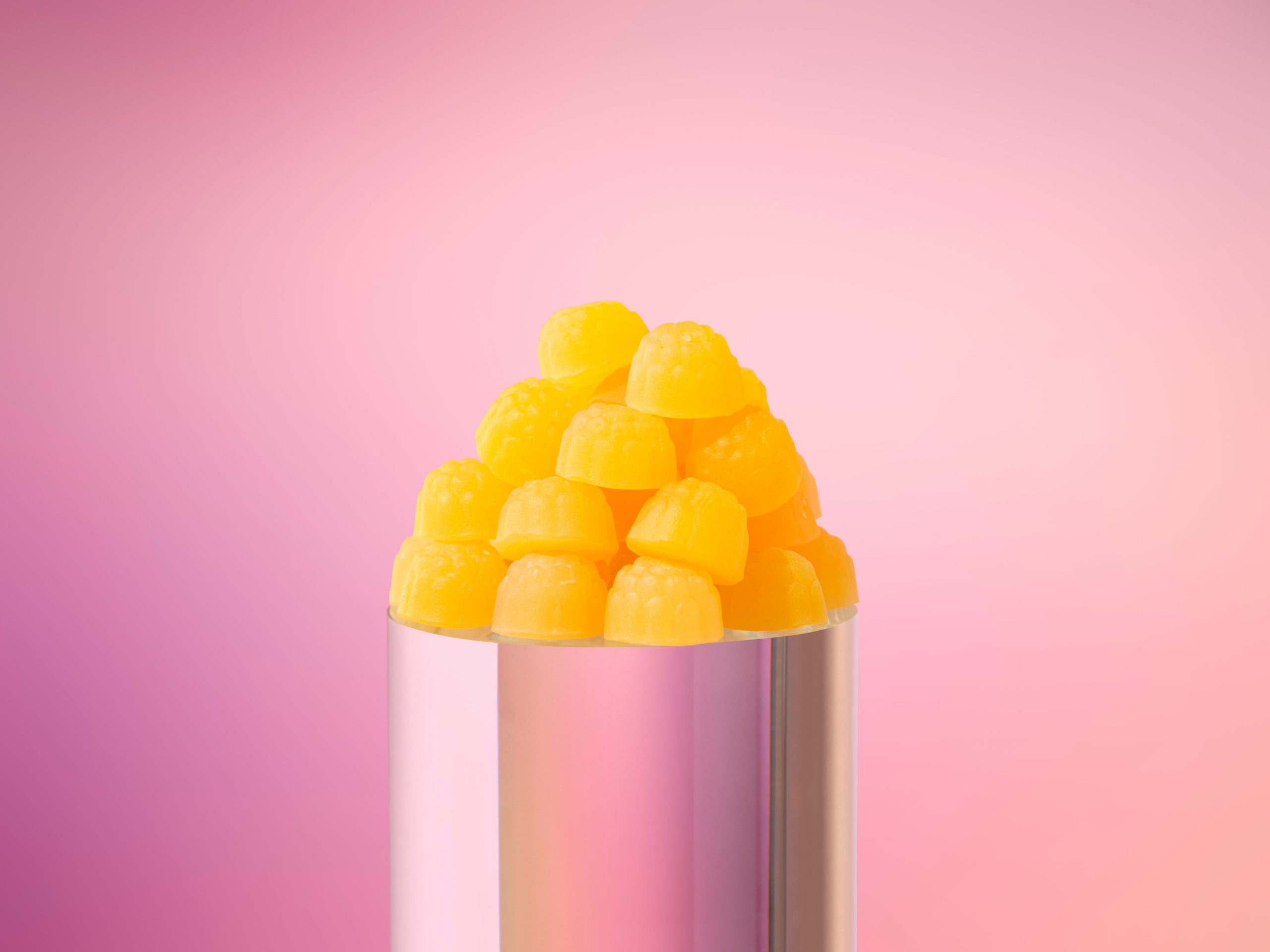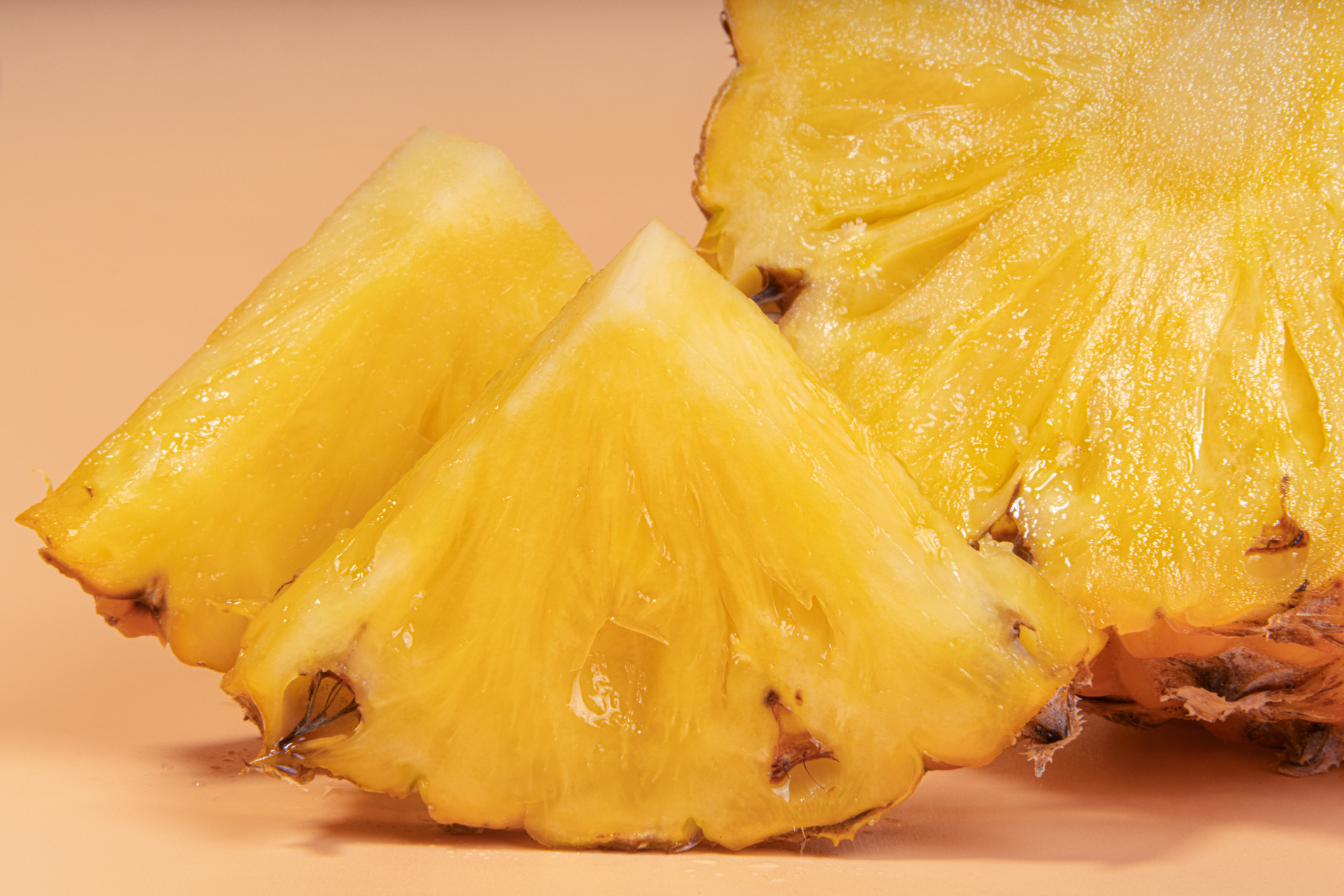Independent Lab Formulation and Testing
Lab Testing to Target Cranberry Powder for Gummy Formulation
An independent lab at Rutgers University did comparative laboratory testing of five cranberry powder extracts to find the form of cranberry that had high bacterial anti-adhesion activity (AAA) and proanthocyanidin (PAC) content to formulate the gummy targeted at maintaining urinary tract health. Preformulation lab testing of the starting materials (cranberry powders) was done to compare the PAC levels and in vitro anti-adhesion activity (AAA) to select potential powder candidates to include in the gummy formulation. Four standardized cranberry extracts and a whole cranberry powder were tested.
PACs were extracted from the powders using the gravimetric method (solid phase chromatography) and the weight of PAC determined for each sample. The target PAC levels for the gummies was 36 mg/serving, which is the amount of PAC that has shown in vivo efficacy in previous clinical studies on cranberry juice and other dietary supplements.
The powders were tested in the lab for in vitro AAA against P-type E. coli, a type of pathogenic bacteria that can cause UTI and kidney infections. When cranberry products are consumed, PACs and their metabolites can inhibit P-type E. coli from attaching to bladder cells. If this attachment step is interrupted in the bladder itself, it can disrupt the initial step in the infection process and prevent UTIs. But infection prevention using any cranberry product can only be confirmed by doing human clinical trials, which are necessary to complete.
The powders that had the highest juice content rather than skin or pulp had the highest in vitro AAA. The other powders and whole cranberry powder had low AAA indicating that the PACs were either degraded or bound up in the cellulose of cranberry pulp and skin. The powder with the highest PAC content and whole product AAA was selected for gummy formulation.
| Cranberry Product | Reference | Batch # | AAA Whole Product (mg/mL) | PAC content (mg/g) | PAC AAA (mg/mL) |
|---|---|---|---|---|---|
| CE15 Cranberry PE 15% proanth | V3846265 | C069/001/D22 | 0.23 | 97 | 0.04 |
| CYSTICRAN PE 10 % proanth | VC846267 | C147/001/A21 | 0.46 | 63 | 0.04 |
| HI-PAC Cranberry PE | EK846179 | A230/005/A21 | 0.94 | 29 | 0.04 |
| NUTRICRAN Cranberry 1% proanth | EK846155 | E270/001/A21 | 7.5 | 9 | 0.07 |
| Cranberry Fruit Juice Powder | EK334225 | C302/020/A21 | 60 | 4 | 4 |
Gummy Formulation
Gummies were then formulated by two different manufacturers and tested to determine if PAC levels were still comparable to the original whole powder and had in vitro AAA in the gummy matrix. Whole product AAA was done, then the PACs were extracted and the levels determined, followed by AAA testing of those isolated PACs to estimate the stability of the PACs in the gummy and their ability to inhibit in vitro bacterial adhesion in the lab tests. Gummies were also tested by a taste panel to determine palatability. One gummy had the highest AAA and highest PAC AAA, which indicated stability. A serving size of two gummies/day would provide the 36 mg target PAC level.
| Sample | Gummy | Weight of 1 gummy | AAA Whole Product (mg/mL) | PAC content (mg PAC/1 gummy) | PAC AAA (mg/mL) |
|---|---|---|---|---|---|
| 1 | Florida Manufacturer | 3.377g | 10.5 | 52.5 | 0.15 |
| 2 | R&D Pharmvista (50 mg CE 15) | 2.883g | 9 | 5.8 | 0.15 |
| 3 | UTI Gummy samples 5-3-22 | 3.204g | 5.7 | 53.8 | 0.15 |
| 4 | Gummy received 9-2022 | 3.072g | 4.8 | 24 | 0.4 |
Moving forward, the lots of cranberry powder and finished gummies should be routinely tested for PAC levels with the DMAC assay using the Procyanidin A2 standard at Complete Phytochemical Solutions (CPS), LLC in Wisconsin which provides independent lab testing services. In addition, they should be tested for bacterial AAA by CPS as well. Rutgers has harmonized the AAA assay methods with CPS. Both these analyses results (including the A2 reference standard used in DMAC method) should be included on the product spec sheets.
Why is 36mg of PAC such an effective dosage and how was this intake level determined?
The 36 mg PAC level often reported in cranberry products refers specifically to the soluble PAC fraction measured exclusively with the procyanidin A2 reference standard (DMAC/A2). It is the recommended daily intake of soluble PAC in products according to large meta-analyses on cranberry clinical trials for UTI prevention (Jepson et al. 2012; Jepson 2013; Williams 2023).
The 36 mg PAC intake level was originally determined about 20 years ago in my lab at Rutgers. An important human clinical trial conducted at Harvard and published in Journal of the American Medical Association in 1994 demonstrated positive effects in reduction in UTI measures after intake of a 300-mL serving of cranberry juice drink (27% cranberry juice cocktail) (Avorn et al. 1994). We isolated the PACs from the 300-mL serving of juice used in the study and determined that it contained 36 mg of PAC. Since this amount of PAC was linked to a clinically relevant vivo, it was adopted as the “effective dose” of PAC. It is quite possible that lower amounts of PAC have activity, but that has not been shown effectively in clinical trials. Additional ex vivo (collecting urine following intake of cranberry with defined PAC doses and testing the urine for bacterial anti-adhesion activity) as well as clinical studies have demonstrated significant urinary AAA (Lavigne et al. 2008; Howell et al. 2010, 2015) and reductions in recurrent UTI (Uberos et al. 2012; Maki et al. 2016; Occhipinti et al. 2016; Ledda et al. 2017; Thomas et al. 2017) when cranberry products with 36 mg of soluble PAC were consumed. A dose-dependent, randomized, double-blind study determined that a minimum of 36 mg of the soluble A-type PAC is required to promote bacterial anti-adhesion activity and contribute to UTI prevention. One 36-mg bioactive cranberry PAC supplement was nearly as effective as a low-dose antibiotic for UTI prevention. And a university-based study found this 36-mg bioactive PAC formula helped to prevent and reduce catheter-associated UTIs, without the side effects and resistance associated with antibiotics.
Traditional over-the-counter cranberry products typically found in grocery stores and pharmacies vary widely in their quality and ingredients. Therefore, they are substantially unreliable for UTI prevention. Laboratory studies of supplement content show that most contain less than 5 mg of PACs, rendering them ineffective for preventing bacterial adhesion to the bladder. For those supplements that claim to contain 36 mg of PACs, it is important to note that variability exists in the bioavailability of PACs present. Some supplements, for example, are made from whole berry or presscake—the dried skins, stems, and seeds of the fruit—and contain mostly insoluble PACs that bind to cell wall components of the cranberry, such as cellulose. It is an essential distinction that this insoluble PAC does not prevent bacterial adhesion to the bladder. Soluble PACs, at high levels necessary for maximum anti-adhesion activity and clinical efficacy, can only be extracted from the pure juice concentrate.
Can you provide some background about the Marucci Center for Blueberry and Cranberry Research?
The Philip E. Marucci Center for Blueberry and Cranberry Research and Extension is a substation of the New Jersey Agricultural Experiment Station of Rutgers University located in Chatsworth, NJ (Burlington County). The United States Department of Agriculture-Agricultural Research Service program is also located at the Center. The Center maintains its own research farm with cranberry bogs and blueberry fields, as well as multiple greenhouse facilities. It houses state-of-the art laboratory facilities, a science library, offices and a conference room.
The Marucci Center’s mission is to generate and disseminate research information directly applicable to the production of high-quality blueberries and cranberries. These areas include developing new cultivars for industry, investigating causes of diseases, insects and weeds that affect blueberries and cranberries and controlling them to minimize pesticide use, and researching the health attributes of these fruits to encourage consumption. The Center promotes practices that allow the berries to adapt to a changing climate and are compatible with the Pinelands ecosystem.
The Marucci Center was first established over 100 years ago at Whitesbog in 1918 under the direction of C.S. Beckwith. Although it was originated to focus solely on cranberry problems, research was gradually devoted to blueberries as the new fledgling cultivated blueberry industry developed. In 1927 the station was moved to Pemberton and then, in 1962, to its permanent new research facilities at Chatsworth, NJ.
Today, the modern research facility, located in the midst of New Jersey’s cranberry and blueberry industry in the Pinelands, is recognized by the federal government as the National Center for Vaccinium Research.
Marucci Center Has a Rich History of Achievement
- The first cultivated highbush blueberry varieties.
- Other successful blueberry varieties such as Duke.
- Identification of the active compounds in cranberry that prevent urinary tract infections.
- Successful control methods for insect pests, such as the blueberry maggot and leafhoppers, that transmit blueberry stunt and cranberry false-blossom disease.
- Demonstration of the crucial role bees play in pollinating both blueberries and cranberries.
- Techniques for applying fungicides to blueberries and cranberries with minimal disturbance to the environment.
Why are PACs effective against UTIs?
Summary
Cranberries are rich in a number of phytochemicals, including anthocyanin pigments (give cranberries their red color and protect the fruit from ultraviolet light), flavonols (serve as insect attractants), and an abundant supply of polyphenolic proanthocyanidins (PACs), or condensed tannins. PACs are produced by the plant in times of stress and they have an astringent quality that deters predators feeding on the young fruit. The PACs found in cranberry are different from those found in other PAC-rich foods, like chocolate and grape that contain single B-type linkages between epicatechin or catechin units. Cranberry PACs have unusual double A-type linkages that are associated with preventing bacterial adhesion in several sites in the body, including the urinary tract, stomach and oral cavity. Bacterial adhesion is the initial step in the infection process and is required to initiate bacterial growth. Thus, inhibiting this adhesion step prevents subsequent colonization and infection. Since cranberry does not kill bacteria as an antibiotic would, there is no pressure for selection of antibiotic resistant strains of bacteria. Therefore, cranberries will not lose their effectiveness over time. It is the powerful bacterial anti- adhesion properties of cranberry PACs that are associated with maintenance of urinary tract health and show promise for prevention of oral biofilms and ulcers. This mechanism of action is very unusual, making cranberry stand out as a unique functional food.
Full details
PACs are also known as condensed tannins which are flavonoid, polyphenolic molecules that can vary in size from two units to over 50 units. The units are mainly epicatechin and they are held together by bonds called linkages. These linkages can be either B-type (single bonds) or A-type (double bonds). In cranberries, the majority of the PACs have A-type linkages. PACs found in other foods such as grapes, red wines, chocolate and tea have all B-type linkages. The A-type PACs in cranberry are unique and complex. Besides imparting astringency to cranberry, they have been associated with some of the major health benefits of the fruit, especially prevention of UTIs.
UTIs are initiated by bacterial adhesion to the bladder wall, followed by bacterial multiplication and colonization of the urinary tract. The major mechanism of action for cranberry and UTI prevention is the inhibition of bacterial adhesion to bladder cells. In order to grow and cause infection, bacteria have to stick to cells. PACs don’t kill the bacteria like antibiotics but rather they prevent this adhesion, interrupting the initial step in the infection process. The bacteria are then flushed from the body in the urine. This is an elegant mechanism because, since it does not kill the bacteria, it does not promote resistance to cranberry – which will retain its potency. The worldwide issue of mounting antibiotic resistance due to over-use is incredibly important since many antibiotics that are routinely used to treat UTIs have lost much of their effectiveness. If cranberry products can be used regularly by consumers to prevent infections, then those antibiotics will ultimately not have to be taken, which helps preserve their efficacy for when they are really needed.
A-type PACs are much better at preventing bacterial adhesion in the body than the B-type PACs when a cranberry product is ingested. The A-type PACs prevent adhesion of multiple strains of E. coli bacteria that cause UTIs. Research evidence suggests that the small A-type PACs and the metabolites of PACs act in the urine to prevent adhesion of bacteria that enter the bladder and potentially cause UTIs. In theory, the larger PACs that do not get broken down by the body may bind to bacteria in the rectum, rendering them unable to adhere to the bladder wall if they migrate into the urinary tract. There is also evidence that these larger PACs prevent E. coli invasion into gut cells, thus reducing the bacterial reservoir in the gut available to cause future UTIs.
Research shows that there are substantial differences among cranberry products in PAC content and shape and number of PACs, including number of “A-type” linkages, which affect their anti-adhesion bioactivity. Independent testing of different cranberry products has determined that water-soluble juice and juice-based powders elicit a rapid and significant urinary anti-adhesion response within 6 hours following ingestion, while insoluble powders made from pulp and skin left over after juicing induce a much less significant response which is delayed until 9-12 hours. The variability in the anti-adhesion results among products made from different cranberry components may be explained based on differences in the chemical structural nature of the PACs (number of A-type linkages, size of PAC molecules, etc.) which influence this bioactivity. The delay in anti-adhesion activity after ingestion of the pulp-based powders may be due to slower breakdown of large PACs that are bound up with the cellulose cell wall material of the cranberry skin. Much of the PAC in these formulations is permanently bound to the cellulose fibers and is not able to promote urinary tract health. There are no government regulations that closely monitor standardization or efficacy of consumer products made from cranberry. Therefore, healthcare providers and consumers must evaluate ingredients in current commercial cranberry products against the proven benchmark of 36-mg bioactive PACs to ensure clinical efficacy for UTI prevention. A reliable product must have rigorous manufacturing standards, transparency of ingredients, and proof of efficacy. PACs can be tested via an internationally recognized standard—i.e., the DMAC/A2 microplate method—therefore allowing for comparison among formulations. Manufacturers should cite data on their 36-mg PAC content, as well as evidence of maximum anti-adhesion activity.



